Root is one of the three main organs of a plant. The others are the stem and the leaf. Most roots are long and round and grow underground. They anchor the plant in the soil. They also absorb water and minerals that the plant needs to grow. In addition, many roots store food for later use by the plant.
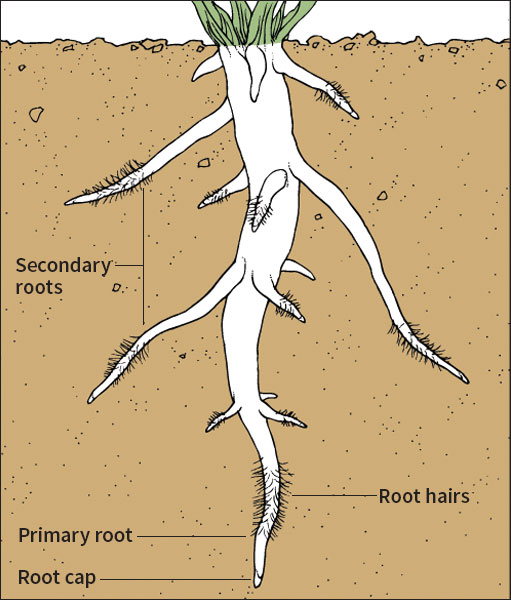
Plants with roots include all seed-producing plants and most spore-producing plants, such as ferns and horsetails. Liverworts, hornworts, and mosses do not have true roots.
Kinds of roots
The first root to develop from a seed is the primary root. It produces many branches called secondary roots. The secondary roots produce branches of their own.
There are two main kinds of root systems, taproot or fibrous. In a taproot system, the primary root grows straight down and is called the taproot. The taproot remains larger than any of the secondary roots throughout the life of the plant. In some plants, including beets and carrots, the taproot becomes fleshy (swollen).
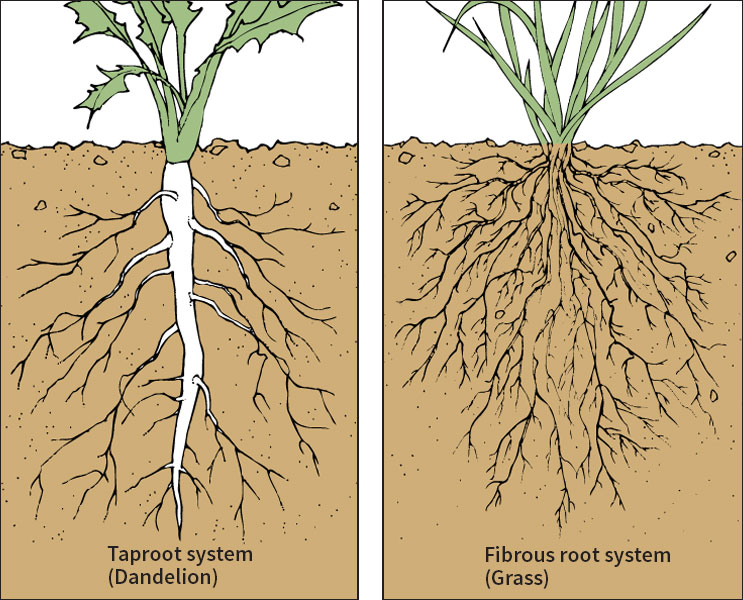
Grass is an example of a plant with a fibrous root system. In such a system, the primary root does not remain larger than the others. Many slender secondary roots grow out in all directions. A fibrous root system may become very extensive. For example, the roots of a rye plant may have a combined length of about 380 miles (612 kilometers).
Some plants have modified roots that perform special functions. Roots that grow from the primary root or its branches are called adventitious roots. They include the prop roots of corn and certain other plants. Prop roots grow down into the soil from the lower part of the stem and help brace the plant against the wind. Some species of orchids and other plants that live on tree branches send out aerial roots, which cling to the branches. Aerial roots absorb water and minerals from the surface of the tree and from the air. Mistletoe is one of the few plants with roots that penetrate the limbs of a tree. These roots, called sinkers, absorb food, water, and minerals directly from the tree.
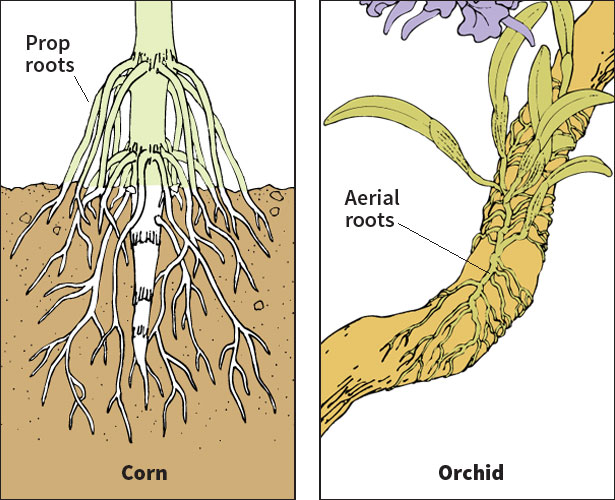
Parts of a root
The root tip.
A root grows in length from an area at its apex (tip). This growth area is called the apical meristem. A meristem is any part of a plant where the cells divide rapidly, forming new cells continually. The apical meristem produces the root cap, a thimble-shaped group of cells. The root cap protects the delicate root tip from damage as the root grows in length and the tip pushes through the soil.
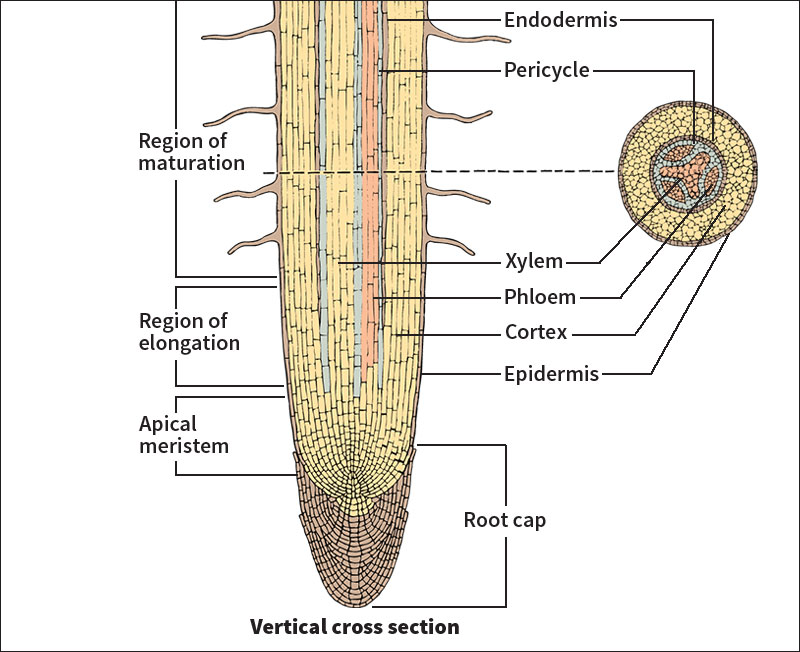
The cells produced by the apical meristem are all small and nearly identical. In the region of elongation, just behind the apical meristem, the cells rapidly grow longer. Farther back lies the region of maturation. There, the cells differentiate–that is, they take on a different structure and appearance according to their functions in the mature root. The distance from the root cap to the region of maturation is only a few tenths of an inch or a few millimeters.
The outer tissues.
The outer layer of cells of a root is called the epidermis. It serves as a sort of skin and protects the tissues beneath. Tiny, hairlike extensions called root hairs grow from the epidermis. The root hairs absorb most of the water and minerals that a plant takes in from the soil. In most kinds of plants, the root hairs live only a few days. They occupy the root hair zone, an area just above the root tip. This area is only a few tenths of an inch or a few millimeters long.
A thick layer of rounded cells called the cortex lies just inside the epidermis. These cells contain stored food and water. The inner layer of cells of the cortex makes up the endodermis.
The core,
or stele, is the central portion of the root. Its outer layer of cells is called the pericycle. Branch roots grow from the pericycle. Inside the pericycle are two kinds of tissues, xylem and phloem. Xylem includes rows of dead, tubular cells called vessels, which conduct water and minerals up to the stem and leaves. Phloem consists largely of rows of long, living cells called sieve tubes. These cells transport food down from the leaves for use or storage by the root. In most roots, the xylem forms a pattern shaped like a star or the spokes of a wheel. The phloem lies between the points of the star or between the spokes.
Secondary tissues.
All the tissues described so far have been primary tissues. Such tissues differentiate from cells created in the apical meristem. Many plants that live just one year have only primary tissues in their roots. But other plants, especially those that live more than one year, have secondary tissues in their roots in addition to primary tissues. The growth of primary tissue adds to the length of a root. Secondary tissues add to the root’s thickness. Secondary-tissue growth produces the large, brown, woody roots in trees, shrubs, and other plants that live for many years.
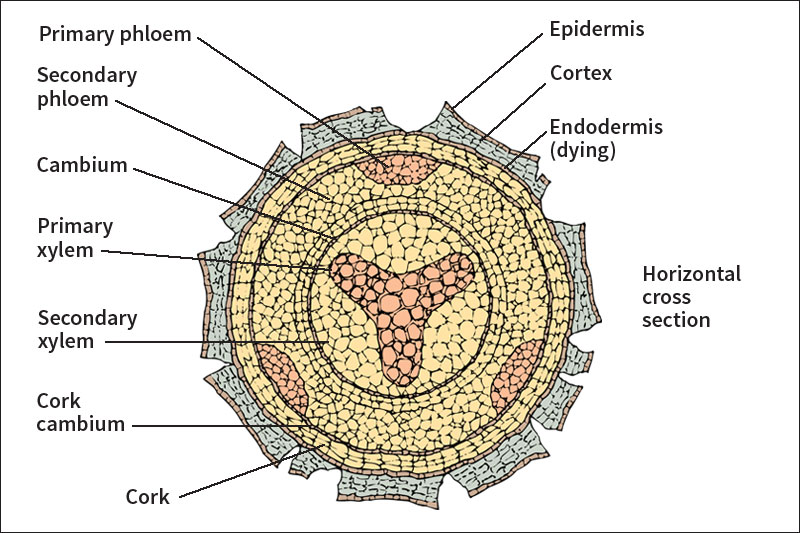
Secondary tissues develop from two meristems. One, called the cork cambium, originates beneath the epidermis, generally in the pericycle. It produces cork cells and pushes them toward the outside of the root. As the cork expands outward, the endodermis, cortex, and epidermis die and peel off. The cork replaces them and becomes the outer covering of the root. The other secondary meristem, the cambium, lies between the primary xylem and the primary phloem. It produces secondary xylem cells toward the center of the root, and secondary phloem cells toward the outside.
The importance of roots
Fleshy taproots rank among the most important vegetables. Fleshy taproots include beets, carrots, radishes, rutabagas, and turnips. Sweet potatoes are a root used not only as food, but also in making alcohol, starch, and syrup. Roots of the cassava plant are a popular food in the tropics. The roots of tropical yams are used in producing cortisone and related drugs.
Roots help prevent erosion of soil by wind and water. Soil is held in place by the dense network of roots of grasses, trees, and other plants. Plants called legumes, which include clover, peas, and soybeans, help enrich the soil. Swellings on their roots contain bacteria that convert nitrogen from the air into compounds. These compounds are useful to the plant. After the plant dies, the compounds become part of the soil.
